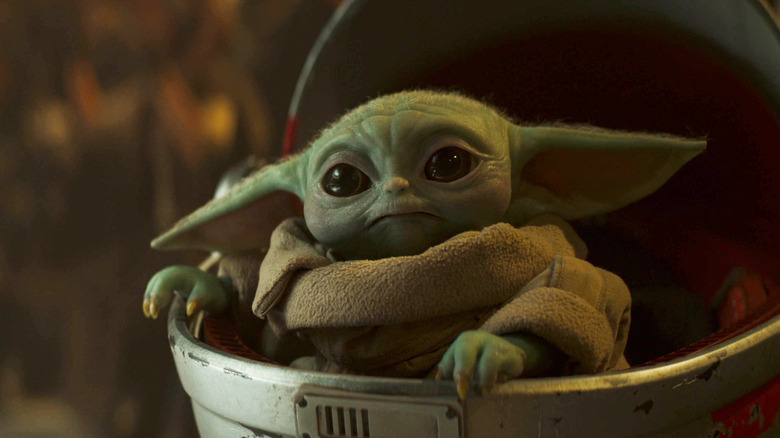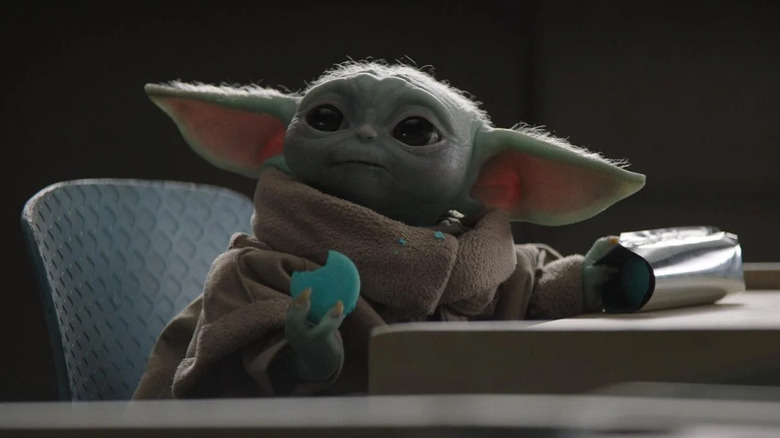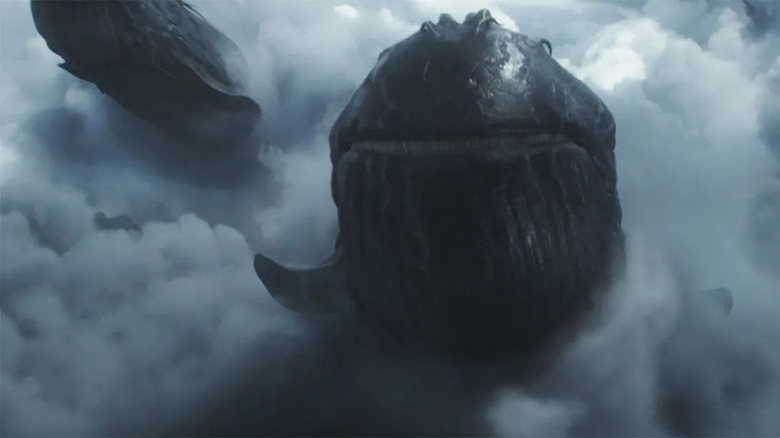Here's Why Star Wars Designers Purposefully Restrict Themselves On Projects
Jon Favreau's "Star Wars" series "The Mandalorian," which debuted in 2019, was the first live-action "Star Wars" TV series and is set only a few years after the events of "Return of the Jedi," but a few decades before the events of "Star Wars: The Force Awakens." Although the titular Mandalorian (Pedro Pascal) is not the fan-favorite bounty hunter character of Boba Fett (who appeared to die in "Return of the Jedi"), the exploration of a similarly-helmeted character likely served to expand on Boba Fett's backstory by proxy. It wouldn't be until later that Boba Fett (Temuera Morrison) would be revealed to have survived "Jedi," and get a TV series of his own.
The first season of "The Mandalorian" involved the transport of an alien infant belonging to the same gremlin-like species as Yoda. The Baby Yoda, named Grogu, became a marketing bonanza, and Grogu merch is now plentiful across all sci-fi collectibles outlets. One cannot deny that the little bugger is cute. Indeed, the character became so popular that he is slated to star in an upcoming theatrically-released "Star Wars" feature film called "The Mandalorian & Grogu."
The Grogu puppet was designed and developed by the talented team at Industrial Light & Magic, and many of the designers felt that the character should be a practical puppet instead of a CGI animated figure. ILM designer Doug Chiang recently spoke with International Cinematographers Guild Magazine and revealed that the many "Star Wars" designers working on "The Mandalorian" and its spinoff "Ahsoka" have to make artistic choices that match the "vibe" of "Star Wars." This means that they will often hold themselves back from using all the newest bells and whistles in the VFX toybox, all to achieve a particular aesthetic.
The old-school Star Wars look
As part of the production process on shows like "The Mandalorian" and "Ahsoka," Chiang and his fellow ILM workers have to keep the low-fi 1970s and 1980s "Star Wars" films in mind when designing creatures and effects. A large part of the early "Star Wars" films' appeal was their cutting-edge practical effects, as well as the shabby handmade qualities of the 1977 original. The initial theatrical cut of "Star Wars" is hard to find in 2024, as new versions with cleaned-up digital effects have come to replace it. Nevertheless, the shabbiness remains a core aspect of the franchise, which is why aliens like Grogu are crafted to retain a human touch that CGI can't emulate. Chiang explained:
"The main key upfront is to capture the personality and feel that it all works. After approval, then we think about practical approaches. Though there aren't any true restrictions on what can be accomplished these days, we make a conscious effort to restrict ourselves on designs. To make this feel old-school 'Star Wars,' we do try to use wilder techniques, not only because they work, but because there is a charm to them. Stop-motion has an old-school charm, but the sensibility and look may not be as pleasing to younger modern audiences, but there's room for different approaches."
As someone born in the 1970s, this author was weaned on stop-motion effects and puppetry in FX-based movies, so I can personally agree 100% with Chiang. Stop-motion and puppetry have an ineffable human touch that CGI has never been able to replicate. Oldsters like me, however, would like to hear how someone born in the early '10s would react to such effects.
Puppet Yoda vs. CGI space whales
Chiang continued to talk about CGI versus the look of practical effects, pointing out that each technique should be wielded correctly. He mentioned the purrgil, a species of space whales featured in the series "Ahsoka," and how that sort of thing — with their ineffable enormity — is better suited to computers. Grogu was definitely a different matter, though, especially when comparing the character to the original Yoda featured in "The Empire Strikes Back." As Chiang put it:
"Grogu could have been a 100% digital character because CGI is just that good now, but we really felt that using a solution like Yoda in 'The Empire Strikes Back' was a better way to go, because of the qualities coming from the human puppeteer performance, which is hard to replicate in CG. On 'Ahsoka,' we have some bold new visuals, such as the CG space whales. Fans of the original films may not understand what they are, but they do fit within established conventions."
Ultimately, though, Chiang aims to dazzle people. He wants audiences to look at his designs and feel awe. "I think part of the appeal of 'Star Wars' design," he said, "is to get viewers wondering, 'What was that in the corner of the frame? I want to know more.' That really helps build out the world."
In an age when just about any visuals can be realized via advanced CGI ("Avatar" broke the world of special effects pretty wide open), it's refreshing to hear a designer talk about the proper use of SFX, rather than just what can be done. It's people like Chiang who assured Grogu was as cute and relatable as he is.


